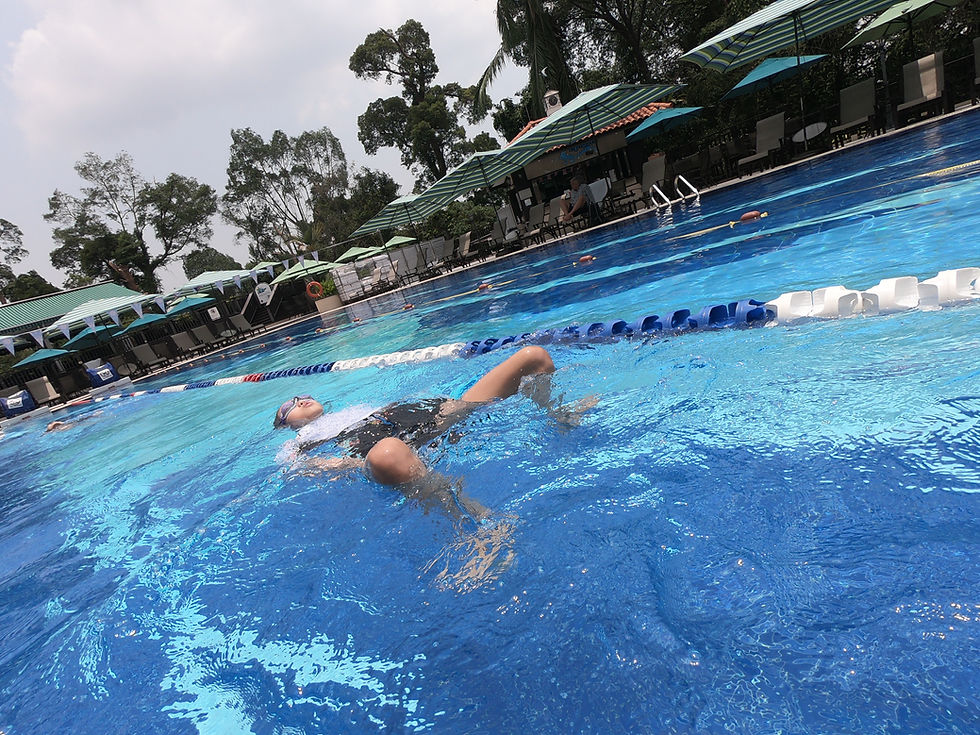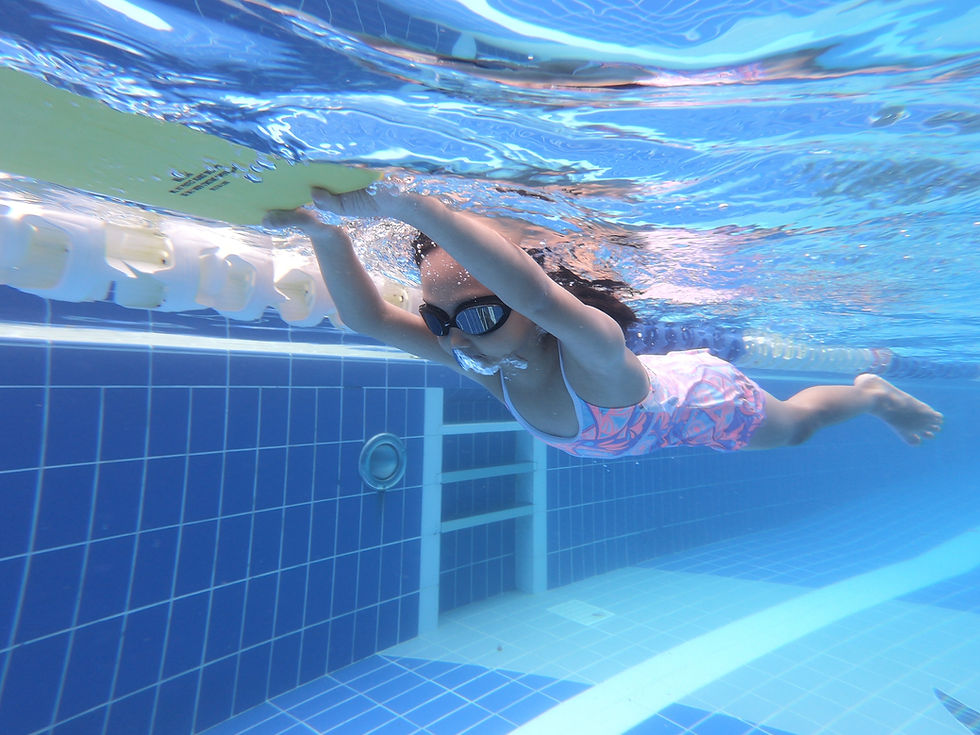The Role of Tempo Drills in Breaststroke Training
- SG Sink Or Swim

- Sep 18, 2025
- 5 min read

Unlocking Rhythm, Efficiency, and Race-Day Speed Through Controlled Cadence
Breaststroke — often described as a “stroke of timing” — lives and dies by rhythm. Unlike freestyle or backstroke, where speed can be generated through sheer turnover or power, breaststroke demands a delicate balance between glide, propulsion, and recovery. Enter: tempo drills.
Tempo training — using tools like the Finis Tempo Trainer or metronome apps to lock in stroke cadence — is not just for freestylers. For breaststrokers, it’s a game-changer. It transforms chaotic, inefficient pulls and kicks into synchronized, hydrodynamic movements that glide farther, faster, and with less effort.
In this article, we’ll explore why tempo drills are essential in breaststroke training, how to implement them at every level, and the measurable benefits they deliver — from technique cleanup to race execution.
🎯 Why Tempo Matters in Breaststroke
Breaststroke is unique: it’s the slowest stroke, yet the most technically demanding. Its speed doesn’t come from raw power — it comes from precision timing.
Common breaststroke flaws that tempo drills fix:
Rushing the pull or kick → killing glide
Holding too long in glide → losing momentum
Inconsistent stroke rhythm → erratic pacing
“Stuttering” between phases → increased drag
“Breaststroke isn’t slow because of the stroke — it’s slow because of bad timing.” — Coach Dave Salo
Tempo drills train your neuromuscular system to fire at the right moment — turning your stroke into a metronome of efficiency.
🧰 Tools of the Trade: The Tempo Trainer
The Finis Tempo Trainer Pro is the gold standard — a small, waterproof beeper you tuck under your cap or goggle strap. It emits an audible beep at intervals you set (in seconds per stroke cycle).
For breaststroke, one “cycle” = 1 full arm pull + 1 full kick + 1 glide.
You can set it to:
Fixed tempo (e.g., 1.5 seconds/cycle) to build consistency
Descending tempo (e.g., start at 1.6s, drop to 1.3s) to build speed under control
Race pace tempo to simulate competition rhythm
No Tempo Trainer? Use a waterproof metronome app and coach feedback — but the beeper’s real-time cue is unmatched.
🏊♀️ How to Use Tempo Drills: A Progressive Framework
➤ Level 1: Finding Your Natural Tempo (Beginner/Recovery Phase)
Goal: Discover your current stroke rhythm without forcing change.
Drill: “Free Tempo Swim”
Swim 4 x 50m breaststroke at easy pace
After each 50, note your average stroke cycles per length (e.g., 6 cycles/25m)
Calculate your natural tempo: Total time ÷ number of cycles
Example: 40s for 8 cycles = 5.0s/cycle → too slow! (Ideal range: 1.2–2.0s/cycle depending on level)
Use this baseline to set starting tempo in structured drills.
➤ Level 2: Locking In Efficient Tempo (Intermediate Technique Phase)
Goal: Train optimal stroke rhythm — balancing glide and propulsion.
Drill: “Fixed Tempo 75s”
Set Tempo Trainer to 1.8s/cycle (adjust based on baseline)
Swim 6 x 75m as:
First 25m: Focus on syncing pull + kick to beep
Second 25m: Add breathing — time inhale with arm recovery
Third 25m: Full stroke — hold tempo, maximize distance per stroke (DPS)
Rest: 30s between reps
Coaching Cue: “Let the beep dictate your rhythm — don’t fight it. Glide to the beep, don’t wait past it.”
Progression: Drop tempo by 0.1s every 2 weeks as efficiency improves.
➤ Level 3: Race Pace Tempo Simulation (Advanced/Competition Phase)
Goal: Lock in competition cadence under fatigue.
Drill: “Tempo Ladder Under Fatigue”
Warm-up with Tempo Trainer at race pace (e.g., 1.4s/cycle)
Main Set: 5 x 100m breaststroke
Rep 1: Easy pace, focus on hitting every beep
Rep 2: 85% effort, hold tempo
Rep 3: 90%, fight to maintain rhythm
Rep 4: 95%, technique under stress
Rep 5: ALL OUT — can you still hit the tempo?
Rest: 60s between reps
If you miss 3+ beeps in a 100, your race tempo is too aggressive — adjust.
➤ Level 4: Tempo Transitions (Elite Speed & Adaptability)
Goal: Teach the body to shift tempos strategically — like in a 200m race.
Drill: “Tempo Pyramid”
1 x 25m @ 2.0s/cycle (long glide, focus on body line)
1 x 25m @ 1.7s/cycle (moderate pace)
1 x 25m @ 1.4s/cycle (race pace)
1 x 25m @ 1.7s
1 x 25m @ 2.0s
Rest 45s — repeat 3–4 rounds
Teaches pacing control and neuromuscular adaptability — critical for 100m/200m strategy.
💡 5 Key Benefits of Tempo Drills in Breaststroke
1. Eliminates “Dead Zones” in Glide
Tempo forces you to initiate the next stroke before momentum dies — maximizing continuous propulsion.
2. Improves Stroke Symmetry & Timing
The beep doesn’t lie. If your left side is slower than your right, you’ll miss the cue — exposing imbalances.
3. Builds Mental Discipline
Swimming to a beep requires focus — especially under fatigue. This translates to better race concentration.
4. Enhances Distance Per Stroke (DPS)
Counterintuitively, a faster tempo often leads to longer glides — because you’re pulling and kicking more efficiently.
“At the right tempo, your body finds its hydrodynamic sweet spot.”
5. Prevents Over-Gliding or Rushing
Two deadly sins of breaststroke. Tempo drills create the “Goldilocks zone” — not too slow, not too fast. Just right.
📊 Sample Weekly Tempo Integration (Age Group/Club Swimmer)
Monday — Technique + Tempo Sync
4 x 50m @ 1.8s w/ fins + snorkel (isolate timing without breath/kick stress)
4 x 50m full stroke @ same tempo
Wednesday — Threshold Tempo
5 x 100m @ 1.6s, 30s rest — hold stroke count, negative split each 100
Friday — Race Simulation
3 x 150m: First 50 @ 1.7s, second 50 @ 1.5s, third 50 @ 1.4s — simulate building tempo in 200m race
Sunday — Recovery + Tempo Awareness
4 x 50m @ 2.0s — focus on perfect streamline, relaxed kick, easy breath
🚫 Common Tempo Training Mistakes (And How to Fix Them)
Setting tempo too fast | Forces rushed, sloppy strokes | Start slower — build up over weeks |
Ignoring stroke count | Speed without efficiency = wasted energy | Aim to reduce strokes at same tempo |
Using tempo only for sprints | Misses endurance and pacing benefits | Use in 200m/400m sets too |
Skipping warm-up to tempo | Body not primed for rhythm | Always begin with 2–3 easy reps |
Fighting the beep | Creates tension → kills glide | Relax into the rhythm — let it guide |
🧠 Pro Tips from Elite Breaststrokers
“I set my Tempo Trainer 0.1s faster than goal pace in practice — so race pace feels slow.”— Lilly King, Olympic Gold Medalist
“Tempo work saved my 200 breast. I used to die on the third 50. Now I own it.”— Coaching journal of NCAA finalist
“If you can hit your tempo when you’re dead tired — you’ll hit it on race day.”
Final Thoughts
Tempo drills aren’t a magic bullet — they’re a metronome for mastery. In breaststroke, where milliseconds are won or lost in the timing of a wrist flick or toe snap, training with tempo transforms chaos into choreography.
Whether you’re a beginner smoothing out your stroke or an elite racer shaving 0.3s off your 100, tempo work belongs in your training plan. It builds rhythm. It builds control. It builds confidence.
So clip on that beeper. Dial in your cadence. And let every beep become a beat in the symphony of your perfect breaststroke.
Sync your stroke. Own your rhythm. Conquer the clock.
Because in breaststroke, the fastest swimmers don’t just move — they move with perfect time. 🐸⏱️💙





Comments